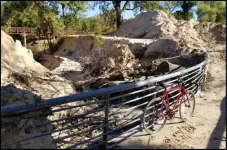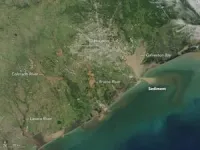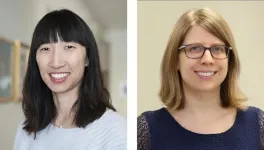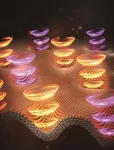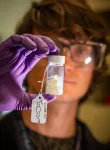(Press-News.org) Enormous amounts of sediment, or sand and mud, flowed through Houston waterways during Hurricane Harvey in 2017, due in part to modifications made by humans to bayous, rivers and streams over the past century, that could seriously impact future flooding events and be costly to the City of Houston.
New analysis by geology researchers at the University of Houston found 27 million cubic meters of sediment, or 16 Astrodomes, moved through 12 Houston waterways and Addicks and Barker reservoirs during Harvey, the largest rainfall event in U.S. history. After the storm, up to five feet of sediment accumulated in the Houston Ship Channel, costing $350 million to dredge it back to its pre-Harvey depth. From August 25 to 31 of 2017, the study found, the amount of sediment moved through Houston was equivalent to about 40% of the sediment discharged annually to the Gulf of Mexico by the Mississippi River.
“We found a strong correlation between stream modification and sediment bypass through those streams,” said Andrew Stearns, first and corresponding author of the study, published in the journal Geology. He conducted much of the work while earning his master’s degree in the laboratory of Julia Wellner, a contributing author and associate professor of geology at UH’s College of Natural Sciences and Mathematics.
River straightening, a type of artificial stream modification, is an engineering technique used to shorten the distance to the ocean and increase water flow, which reduces flooding in surrounding areas. Straightening can be as minor as removing bank vegetation or as extreme as replacing the banks and channel floor with concrete. The technique was used on Houston’s waterways in the 1940s and ‘50s and opened development areas for additional homes and buildings. However, as the study authors found, an unintended consequence is more sediment moves downstream as well.
“Our study provides policymakers with vital information for sediment management in urban watersheds. Not much attention has been given to sediment management, but it has big implications for the city itself, and can be quite costly when omitted from a watershed plan,” added Stearns.
He and the researchers report sediment deposits during Harvey decreased holding capacities in Addicks and Barker reservoirs by about 1.2% and 1.6% respectively.
“If Harvey were to happen again today, there would be less room for water in Addicks and Barker reservoirs because of the sediment that got left behind from Harvey,” Wellner said. “That’s the significance – sediment takes up space no longer available for water.”
Stearns uses Lake Houston as an example. A large sand bar recently emerged from the water where the west fork of the San Jacinto River enters the lake near Kingwood. The U.S. Army Corps of Engineers has dredged the top of the bar several times in recent years. “If you have this big mound of sediment blocking water flow to the lake, there’s less area for the water to go,” he said. “During floods, the water goes around that bar of sediment, and into somebody’s house.”
The research team used lidar, or light detection and ranging, a remote sensing technology that measures the elevation of the ground surface, to reach their conclusions, in addition to some ground observations. Lidar allowed them to determine the elevation change from pre-storm to post-storm due to sediment movement.
Causes of Massive Sediment Movement
Stearns said there was so much sediment in the waterways due to compounding factors of the deluge of rain and human modifications to the surrounding environment.
“We found 75% of Houston received over three feet of rain in five days,” he said. “When you get nearly your annual rainfall in such a short amount of time, that’s going to move large amounts of sediment quickly.”
Whether humans created or contributed to more sediment, Stearns and Wellner say it is likely. Because urban sprawl has covered prairie and natural green spaces with impermeable concrete, more water flows into drains and eventually to surrounding bayous. And with more developed land, erosion rates are higher as well, which contributes to the sediment.
“With more rainfall, more run off and more erosion, you are moving more sediment moving through bayous and rivers,” Stearns said.
Information for Policymakers on a Budding Research Topic
The team hopes their study leads researchers and policymakers to collect data on regional sediment movement on a regular basis, not only because of how costly it is to dredge sediment out of waterways, as seen in the ship channel, but also because of the potential impact it can have on flooding in the Houston area. Additionally, they want policymakers to see the impact river straightening can have on sediment movement.
“This study is just the beginning for understanding sediment movement through urban environments,” said Stearns. "With current technology, we were only able to see above-water, but there’s a lot of opportunity to look at underwater sediment movement as well.”
Shuhab Khan, professor of geology at UH, and Jerome Kendall of the University of New Mexico are contributing authors of the study.
END
Sediment movement during Hurricane Harvey could negatively impact future flooding, prove costly to Houston, UH study finds
Researchers correlate stream modification to sediment movement in Houston area during Hurricane Harvey
2023-08-25
ELSE PRESS RELEASES FROM THIS DATE:
USC-supported startup receives major grant for clinical trial of a promising eye treatment
2023-08-24
A stem cell patch developed by USC researchers for patients with macular degeneration will soon be tested in a phase 2b clinical trial.
This latest milestone in the patch’s development was made possible by a combined $21 million in support from a state organization, a nonprofit foundation and the university. Last month, the California Institute for Regenerative Medicine (CIRM) awarded an estimated $12.4 million to the USC-supported startup Regenerative Patch Technologies (RPT) to test the safety and efficacy ...
New detector paves the way to large-scale optical neural networks
2023-08-24
For the first time, researchers have used a surface normal nonlinear photodetector (SNPD) to improve the speed and energy efficiency of a diffractive optical neural network (ONN). The new device lays the groundwork for large-scale ONNs, which can perform high-speed processing at the speed of light in an extremely energy efficient manner.
Farshid Ashtiani from Nokia Bell Labs will present this research at Frontiers in Optics + Laser Science (FiO LS), which will be held 9 – 12 October 2023 at the Greater Tacoma Convention ...
The right combo: Getting the most health benefits from fruit smoothies
2023-08-24
Smoothies can be a tasty and convenient way to get the important fruits and vegetables you need for a healthy diet. But is a banana and blueberry smoothie the best combo? Researchers at the University of California, Davis, suggest that blending certain ingredients in smoothies can influence whether your body is getting a nutritional boost.
The study, published today in the Royal Society of Chemistry’s journal Food and Function, used smoothies to test how various levels of polyphenol oxidase, an enzyme in many fruits and vegetables, affects the levels of flavanols in food to be absorbed by the body. Flavanols ...
$12 million grant funds foundational research on early liver transplantation
2023-08-24
Alcohol-associated liver disease accounts for 50% of liver-related deaths, and its rates are rising worldwide. But one of the best treatment options, early liver transplantation (ELT)—transplants done with no mandatory period of abstinence from alcohol—is also one of the most controversial, partly because of concerns that patients will relapse to alcohol after transplantation.
Part of the problem is that livers for transplants are in short supply, and researchers lack data to determine who will benefit most from ELT. Studies show that decisions about who gets a transplant can, at times, be influenced by bias or unsystematic. ...
Study shows technology boosts public health programs
2023-08-24
An examination of the SCALE-UP Counts program was recently published in the journal Pediatrics. This analysis, led by Yelena Wu, PhD, investigator at Huntsman Cancer Institute and associate professor in the department of dermatology at the University of Utah (the U), and David Wetter, PhD, MS, investigator at Huntsman Cancer Institute and professor in the department of population health sciences at the U, received support from RADx-Underserved Populations (RADx-UP) and funding from the National Institute of Health (NIH).
The SCALE-UP Counts program was designed to promote COVID-19 testing through collaboration ...
A global observatory to monitor Earth's biodiversity
2023-08-24
At a time of nature crisis driven by unparalleled rates of biodiversity loss, a new interconnected system to monitor biodiversity around the world is urgently needed to direct and focus conservation action.
"The lethal combination of habitat loss, the exploitation of natural populations, pollution, and climate change is causing species extinction rates not seen since the last mass extinction 65 million years ago," said Prof. Andrew Gonzalez, Liber Ero Chair in Conservation Biology at McGill University, and co-Chair of GEO BON. "We lack the means to monitor these impacts ...
High drug price associated with decreased treatment retention for patients with chronic liver disease
2023-08-24
MINNEAPOLIS/ST. PAUL (08/24/2023) — Researchers from the University of Minnesota Medical School and College of Pharmacy have found that high costs for hepatic encephalopathy treatment in patients with end-stage liver disease were associated with decreased treatment retention for patients. The study results were recently published in Hepatology Communications.
Hepatic encephalopathy is the loss of brain function that occurs in people with severe liver disease. The condition is associated with high morbidity and mortality. ...
Optimizing tobacco cessation treatment with lung cancer screening
2023-08-24
MINNEAPOLIS/ST. PAUL (08/24/2023) —Lung cancer is the deadliest cancer in the United States, and 80% of lung cancer deaths are linked to one risk factor: smoking. While lung cancer screenings are a critical part of prevention and treatment for the disease and 15 million Americans qualify for yearly screenings, over half those eligible for screenings are still actively smoking. Without standard smoking cessation measures in place, the benefits of the screenings have not been fully realized.
New ...
New quantum device generates single photons and encodes information
2023-08-24
A new approach to quantum light emitters generates a stream of circularly polarized single photons, or particles of light, that may be useful for a range of quantum information and communication applications. A Los Alamos National Laboratory team stacked two different, atomically thin materials to realize this chiral quantum light source.
“Our research shows that it is possible for a monolayer semiconductor to emit circularly polarized light without the help of an external magnetic field,” ...
Making materials more durable through science
2023-08-24
ALBUQUERQUE, N.M. — A team at Sandia National Laboratories developed a molecule that helps change the way some materials react to temperature fluctuations, which makes them more durable. It’s an application that could be used in everything from plastic phone cases to missiles.
Polymers, which include various forms of plastics, are made up of many smaller molecules, bonded together. This bond makes them especially strong and an ideal product to be used to protect delicate components in a wide variety of items. But with time, use and exposure to different environments, all materials begin to deteriorate.
Hot ...
LAST 30 PRESS RELEASES:
Tracing the quick synthesis of an industrially important catalyst
New software sheds light on cancer’s hidden genetic networks
UT Health San Antonio awarded $3 million in CPRIT grants to bolster cancer research and prevention efforts in South Texas
Third symposium spotlights global challenge of new contaminants in China’s fight against pollution
From straw to soil harmony: International team reveals how biochar supercharges carbon-smart farming
Myeloma: How AI is redrawing the map of cancer care
Manhattan E. Charurat, Ph.D., MHS invested as the Homer and Martha Gudelsky Distinguished Professor in Medicine at the University of Maryland School of Medicine
Insilico Medicine’s Pharma.AI Q4 Winter Launch Recap: Revolutionizing drug discovery with cutting-edge AI innovations, accelerating the path to pharmaceutical superintelligence
Nanoplastics have diet-dependent impacts on digestive system health
Brain neuron death occurs throughout life and increases with age, a natural human protein drug may halt neuron death in Alzheimer’s disease
SPIE and CLP announce the recipients of the 2025 Advanced Photonics Young Innovator Award
Lessons from the Caldor Fire’s Christmas Valley ‘Miracle’
Ant societies rose by trading individual protection for collective power
Research reveals how ancient viral DNA shapes early embryonic development
A molecular gatekeeper that controls protein synthesis
New ‘cloaking device’ concept to shield sensitive tech from magnetic fields
Researchers show impact of mountain building and climate change on alpine biodiversity
Study models the transition from Neanderthals to modern humans in Europe
University of Phoenix College of Doctoral Studies releases white paper on AI-driven skilling to reduce burnout and restore worker autonomy
AIs fail at the game of visual “telephone”
The levers for a sustainable food system
Potential changes in US homelessness by ending federal support for housing first programs
Vulnerability of large language models to prompt injection when providing medical advice
Researchers develop new system for high-energy-density, long-life, multi-electron transfer bromine-based flow batteries
Ending federal support for housing first programs could increase U.S. homelessness by 5% in one year, new JAMA study finds
New research uncovers molecular ‘safety switch’ shielding cancers from immune attack
Bacteria resisting viral infection can still sink carbon to ocean floor
Younger biological age may increase depression risk in older women during COVID-19
Bharat Innovates 2026 National Basecamp Showcases India’s Most Promising Deep-Tech Ventures
Here’s what determines whether your income level rises or falls
[Press-News.org] Sediment movement during Hurricane Harvey could negatively impact future flooding, prove costly to Houston, UH study findsResearchers correlate stream modification to sediment movement in Houston area during Hurricane Harvey
